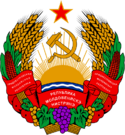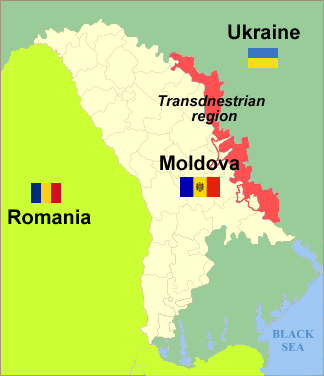Transnistria
| Pridnestrovian Moldavian Republic
Република Молдовеняскэ Нистрянэ
(Republica Moldovenească Nistreană) Приднестрóвская Молдáвская Респýблика (Pridnestrovskaya Moldavskaya Respublika) Придністровська Молдавська Республіка (Pridnistrovs'ka Moldavs'ka Respublika) |
||||||
|---|---|---|---|---|---|---|
|
||||||
| Anthem: Anthem of Transnistria |
||||||
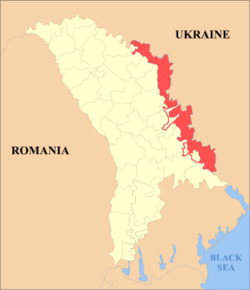 |
||||||
| Capital (and largest city) |
Tiraspol |
|||||
| Official languages | Moldovan (only official in its Cyrillic form), Russian, Ukrainian | |||||
| Ethnic groups (2005) | 32% Moldovans 31% Russians 29% Ukrainians |
|||||
| Government | Internationally unrecognized semi-presidential republic | |||||
| - | President of the Transnistrian Moldovan Republic | Igor Smirnov | ||||
| Autonomous territory of the Republic of Moldova that is de facto independent | ||||||
| - | Declaration of Independence | September 2, 1990 | ||||
| - | War of Transnistria | March 2 - July 21, 1992 | ||||
| - | Recognition | by non-recognized entities only1 | ||||
| Area | ||||||
| - | Total | 4,163 km2 1,607 sq mi |
||||
| - | Water (%) | 2.35 | ||||
| Population | ||||||
| - | 2007 estimate | 537,000[1] | ||||
| - | 2004 census | 555,347 | ||||
| - | Density | 133/km2 345/sq mi |
||||
| Currency | Transnistrian ruble2 (PRB) |
|||||
| Time zone | EET (UTC+2) | |||||
| - | Summer (DST) | EEST (UTC+3) | ||||
| Internet TLD | none3 | |||||
| Calling code | +373 spec. +373 5 and +373 2 | |||||
| 1 | Limited to Abkhazia and South Ossetia, both unrecognized, see Commonwealth of Unrecognized States | |||||
| 2 | Moldovan leu used in the localities under Moldovan control and in the security zone | |||||
| 3 | .ru and .md sometimes used. | |||||
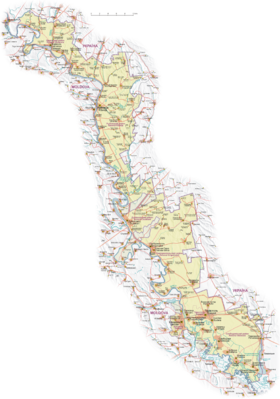
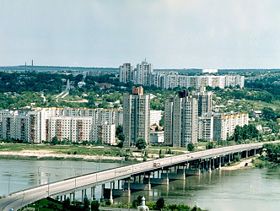
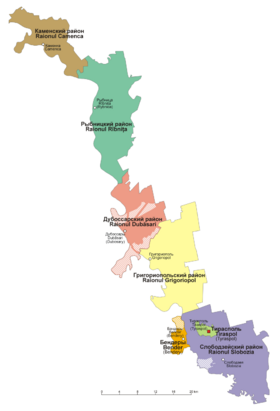
Transnistria, also known as Trans-Dniester, Transdniestria, and Pridnestrovie (full name: Pridnestrovian Moldavian Republic, or PMR), is a "breakaway republic" [2][3] also claimed by Moldova. (The international community supports Moldova's territorial claim to the territory, with the claimed official status of an autonomous territory. It is de jure part of Moldova and de facto an independent[4][5][6] state.)[7] It is organised as a presidential republic, with its own government, parliament, military, police, postal system, and currency. Its authorities have adopted a constitution, flag, national anthem, and a coat of arms.
Transnistria is located mostly in a strip between the Dniester River and Ukraine. After the dissolution of the USSR, Transnistria declared independence leading to the war with Moldova that started in March 1992 and was concluded by the ceasefire of July 1992. As part of that agreement, a three-party (Russia, Moldova, PMR) Joint Control Commission supervises the security arrangements in the demilitarized zone, comprising 20 localities on both sides of the river. Although the ceasefire has held, the territory's political status remains unresolved, and Transnistria has been de facto independent since that time.
Transnistria is sometimes compared with other post-Soviet frozen conflict zones such as Nagorno-Karabakh, Abkhazia, and South Ossetia.[8][9] The latter two since declaring their independence from Georgia after the 2008 South Ossetia war have subsequently recognised Transnistria as an independent state and plan to establish diplomatic relations in return for the recognition of themselves.[10]
Contents |
Names
It is known in English as Transnistria (which is also the name of the region in Romanian), Trans-Dniester[11] or Transdniestria[12]. Its formal long name is its name in Russian Pridnestróvskaia Moldávskaia Respública (Moldovan: Republica Moldovenească Nistreană, Moldovan Cyrillic alphabet: Република Молдовеняскэ Нистрянэ, Russian: Приднестровская Молдавская Республика, Ukrainian: Придністровська Молдавська Республіка, ПМР, English: Pridnestrovian Moldavian Republic), as used by the breakaway Transnistrian authorities. This is abbreviated PMR. The short form of this name is Pridnestrovie (transliteration of the Russian "Приднестровье").[13]
Etymologically, all the names come down to similar spelling variants of Transnistria, meaning "beyond the river Dniester", or Pridnestrovie, meaning "by the river Dniester".
Some documents of the government of Moldova refer to the region Stînga Nistrului (Unităţile Administrativ-Teritoriale din Stînga Nistrului), which means "Left Bank of the Dniester" ("Administrative-territorial unit of the Left Bank of the Dniester").
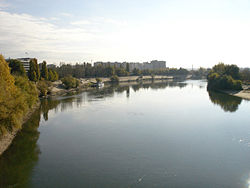
Geography
- See also Border issues
Transnistria is landlocked and borders Bessarabia (i.e. the rest of Moldova, for 411 km) to the West, and Ukraine (for 405 km) to the East. It is a narrow valley stretching in the North-South direction along the bank of the Dniester River, which forms a natural boundary along most of the border with (the rest of) Moldova. Tiraspol, the capital and largest city of Transnistria, has 159,163 inhabitants.
The territory of Transnistria is mostly, but not completely coincident with the left (eastern) bank of Moldova (with respect to Dniester). It includes ten cities and towns, and 69 communes, with a totality of 147 localities (counting the unincorporated ones as well). Ten localities on the left bank are controlled by the Moldovan government, as part of the Dubăsari district. They are situated north and south of the city of Dubăsari, which itself is under Transnistrian control.
On the west bank, the city of Bendery and six villages to its south and south-east, roughly opposite Tiraspol, are controlled by Transnistrian authorities.
The ten localities controlled by the Moldovan authorities on the eastern bank, the city of Dubăsari (situated on the eastern bank and controlled by Tiraspol), the seven localities controlled by the Transnistrian authorities on the western bank, as well as two (Varniţa and Copanca) on the same bank under Chişinău control form a security zone. The security situation inside it is subject to the Joint Control Commission rulings.
The main transportation route in Transnistria is the road Tiraspol-Dubăsari-Rîbniţa. North and south of Dubăsari it passes through the lands of the villages controlled by the central government (Doroţcaia, Cocieri, Roghi, while Vasilievca is entirely situated east of the road). Conflict erupted on several occasions when the Tiraspol authorities prevented the villagers from reaching their farmland east of the road.[14][15][16]
Transnistrians are able to travel (normally without difficulty) in and out of the territory under PMR control to neighbouring Moldovan-controlled territory, Ukraine, and on to Russia, by road or (when service is not interrupted by political tensions) on two international trains, the year-round Moscow-Chişinău, and the seasonal Saratov-Varna.[17] International air travellers rely on the airport in Chişinău, the Moldovan capital, or the airport of Odessa in the Ukraine.
Administrative subdivisions
Transnistria is subdivided into five raions (Russian names are listed in parentheses):
- Camenca (Кáменка, Kamenka)
- Dubăsari (Дубоссáры, Dubossary)
- Grigoriopol (Григориóполь, Grigoriopol')
- Rîbniţa (Рыбница, Rybnitsa)
- Slobozia (Слободзéя, Slobodzeya)
and one (two) municipalities:
- Bendery (Бендéры), not part of Territorial Unit Transnistria of Moldova, but part of PMR.
- Tiraspol (Тирáсполь)
Political status
Transnistria is internationally recognised as being a legal part of the Republic of Moldova, although de facto control is exercised by its internationally unrecognised government which declared independence from Moldova in 1990 with Tiraspol as its declared capital.
Prior to unification of the territory with Moldova in 1940, Tiraspol was the capital of the Moldavian ASSR, an autonomous republic within Ukrainian SSR, which existed from 1924 to 1940.
Although exercising no direct control over the territory, the Moldovan government passed the "Law on Basic Provisions of the Special Legal Status of Localities from the Left Bank of the Dniester" on July 22, 2005, which established Transnistria as a separate territorial unit within the Republic of Moldova, which can be given a status of a large autonomy. The law was passed without any prior consultation with the de facto government in Transnistria, which felt that it was a provocation and has since ignored it.
Between 300,000 and 400,000 Transnistrians (the majority of the population) acquired Moldovan passports by 2008. No country recognizes passports issued by the Transnistrian government.[18][19] Russia opened a consulate in Tiraspol (against the will of Moldova) and issued about 80,000 passports to Transnistrians by the end of 2006.[20]
There are unsettled border issues between the PMR and Moldova. Nine villages from the Dubăsari district, including Cocieri and Doroţcaia which geographically belong to Transnistria, have been under the control of the central government of Moldova after the involvement of local inhabitants on the side of Moldovan forces during the War of Transnistria. These villages along with Varniţa and Copanca, near Bendery and Tiraspol, are claimed by the PMR. One city and six villages on the west bank are controlled by the Transnistrian authorities, but are considered by Moldova as a separate municipality (Bendery and two villages), or part of the Căuşeni district (four villages).
Tense situations have periodically surfaced due to these territorial disputes, for example in 2005, when Transnistrian forces entered Vasilievca[21], in 2006 around Varniţa, and in 2007 in Dubăsari-Cocieri area, when a confrontation between Moldovan and Transnistrian forces occurred, however without any casualties.
According to Moldovan sources, in 13 May 2007 the mayor of the village Corjova, which is under Moldovan government control, was arrested by Transnistrian police, together with a councillor of Moldovan-controlled part of Dubăsari district.[22]
Politics

Transnistria has a multi-party system and a unicameral parliament named the Supreme Council. Its legislature has 43 members elected by proportional representation.[23] The president is elected to a five year term by popular vote.
Igor Smirnov has been the President of Transnistria since the declaration of independence in 1990 and he is currently serving his fourth mandate after being reelected in December 2006. In the latest parliamentary election in December 2005 the Renewal movement defeated the Republic movement and won an overall majority, its leader Yevgeni Shevchuk becoming speaker of parliament.[24]
According to official PMR data, only 15 of the 43 members of its parliament were born in the territory of Transnistria (including 12 in Transnistria proper, and 3 in the Bessarabian area of Bendery-Chiţcani, which is controlled by Transnistria), while 4 others in the rest of Moldova, with the remainder mainly born in Russia or Ukraine.[25] Igor Smirnov, the leader of PMR, arrived in the region in 1987. Most of the MPs who were born elsewhere had moved to the region ten years or more before the conflict erupted.[26] Despite the fact that Moldovans are around a third of Transnistrian population, no ethnic Moldovans are members in the Transnistrian council of ministers.[27]
There is disagreement as to whether elections in Transnistria are free and fair.[28] The political regime has been described as one of 'super-presidentialism'.[29]
Election results are considered suspicious, as in 2001 in one region it was reported that Igor Smirnov collected 103.6% of the votes.[30] Nevertheless, some organizations, such as CIS-EMO, have participated and have called them democratic.
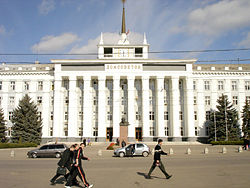
The Narodovlastie party and Power to the People movement faced numerous problems in 2001-2002 and were eventually closed.[31][32]
A list published by the European Union bans travel to the EU of some members of the PMR leadership.[33]
In 2007 the registration of Social Democratic Party was allowed. This party, led by former separatist leader and member of PMR government Andrey Safonov, is allegedly in favor of a union with Moldova.[34] In the latest presidential election the registration of opposition candidate Andrey Safonov was delayed until a few days before the vote, so that he had little time to conduct an election campaign.[35][36]
In September 2007, the leader of the Transnistrian Communist party, Oleg Horjan, was sentenced at a suspended sentence of 1½ years imprisonment for organising unsanctioned actions of protest.[37]
According to the Transnistrian referendum, 2006, carried out by the PMR government the population voted overwhelmingly in favour of "independence from Moldova and free association with Russia". Although the results may not be completely reliable, it is still likely that most Transnistrians support an eventual union with Russia.[20]
International relations
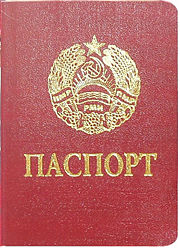
Transnistria's minister of foreign affairs is Vladimir Yastrebchak. He is the replacement of longtime foreign minister Valeriy Anatolievich Litskai, who was fired on July 1, 2008,[38][39] for not showing any progress in advancing Transnistria's currently still unrecognized status.
Transnistria border customs dispute
On March 3, 2006, Ukraine introduced new customs regulations on its border with Transnistria. Ukraine declared that it would only import goods from Transnistria with documents processed by Moldovan customs offices, as part of the implementation of the joint customs protocol between Ukraine and Moldova on December 30, 2005. Transnistria and Russia termed the act an "economic blockade".
The United States, the European Union and OSCE approved the Ukrainian move, while Russia saw it as a means of political pressure. On March 4, Transnistria responded by blocking the Moldovan and Ukrainian transport at the borders of Transnistria. The Transnistrian block was lifted after two weeks. However, the Moldovan/Ukrainian block remains in place, and holds up progress in status settlement negotiations between the sides.[40] In the months following the regulations, exports from Transnistria nosedived. Transnistria declared a "humanitarian catastrophe" in the region, while Moldova called it "deliberate misinformation."[41] Cargoes of humanitarian aid were sent from Russia in response.[42]
Russian military presence in Transnistria
- See also: 14th Army involvement in Transnistria
A 1,200-strong Russian military contingent is present in Transnistria. The status of this contingent is disputed. The 1992 cease-fire agreement between Moldova and Transnistria established a Russian peace-keeper presence in Transnistria. Russian troops stationed in Moldova proper since the time of the USSR were fully withdrawn to Russia by January 1993.
On October 21, 1994, Russia and Moldova signed an agreement that committed Russia to the withdrawal of the troops in three years from the date of entry into force of the agreement,[43] this however did not come into effect because the Russian Duma did not ratify it.[7] The Treaty on Conventional Armed Forces in Europe (CFE) included a paragraph about the removal of Russian troops from Moldova's territory and was introduced into the text of the OSCE Summit Declaration of Istanbul (1999), in which Russia had committed itself to pulling out its troops from Transnistria by the end of 2002.[44] However, even after 2002, the Russian parliament did not ratify the Istanbul accords. On July 19, 2004, after it finally passed through parliament President Vladimir Putin signed the Law on the ratification of the CFE Treaty in Europe, which committed Russia to remove the heavy armaments limited by this Treaty.[45] During 2000-2001, although the CFE Treaty was not fully ratified, in order to comply with it, Moscow withdrew 125 pieces of Treaty Limited Equipment (TLE) and 60 railway wagons containing ammunition from the Transnistrian region of Moldova. In 2002, Russia withdrew only 3 military equipment trains (118 railway wagons) and 2 of ammunition (43 wagons) from the Transnistrian region of Moldova, and in 2003, 11 rail convoys transporting military equipment and 31 transporting ammunitions. According to the OSCE Mission to Moldova, of a total of 42,000 tons of ammunitions stored in Transnistria, 1,153 tons (3%) was transported back to Russia in 2001, 2,405 tons (6%) in 2002 and 16,573 tons (39%) in 2003.
Andrei Stratan, the Minister of Foreign Affairs of Moldova stated in his speech during the 12th OSCE Ministerial Council Meeting in Sofia on December 6-December 7, 2004 that "The presence of Russian troops on the territory of the Republic of Moldova is against the political will of Moldovan constitutional authorities and defies the unanimously recognized international norms and principles, being qualified by Moldovan authorities as a foreign military occupation illegally deployed on the territory of the state".[46][47] As of 2007 however, Russia insists that it has already fulfilled those obligations. It states the remaining troops are serving as peace-keepers authorized under the 1992 ceasefire, are not in violation of the Istanbul accords and will remain until the conflict is fully resolved.[48]
In a NATO-resolution from 18 November 2008, Russia was urged to respect its commitments which were taken at the Istanbul OSCE Summit in 1999 and has to withdraw its illegal military presence from the Transdnestrian region of Moldova in the nearest future.[49]
History
Antiquity and Middle Ages
The area where Transnistria is now located has been inhabited by Indo-European tribes for millennia, being a borderland between Dacia and Scythia. The Ancient Greek Miletians founded about 600 BC a colony named Tyras, situated on the right bank, in the mouth of the Dniester river (Tyras), on the site of the present day city Bilhorod-Dnistrovskyi in Ukraine. The city later fell to the Romans. Early Germanic and Mongolic tribes were present in the area during their invasions of the Roman Empire.
South Slavs were present in Transnistria from the second half of the 6th century. In the early Middle Ages, Slavic tribes of Tivertsi and Ulichs[50] populated larger areas, including Transnistria, followed by Turkic nomads such as the Petchenegs[51] and Cumans. Possibly an early part of Kievan Rus', after the Mongol invasion of Europe in 1241, the territory was briefly under Mongol control (yet probably without any permanent settlements), and later under the Crimean Khanate.
From the 15th century, northern Transnistria (current districts of Camenca and Rîbniţa) belonged to the Grand Duchy of Lithuania[52][53][54][55][56], and later to the Kingdom of Poland, which encouraged the migration of peasants into the territory from the neighboring populated areas (from north and from west). Prince of Moldavia Gheorghe Duca (1665-66, 1668-72, 1678-84) built a court at Ţicanova on the east bank of the Dniester, and one at Nimirov on the Southern Bug, last mentioned in Moldavian hands in 1765.[57] [58] The localities Dubăsari, Raşcov, Vasilcău, as well as four other currently in Ukraine are mentioned in 17th-18th centuries as fairs for the Dniester-Bug region. In 1769 a document dated at Bendery mentions the then title of the Mitropolitan of Moldavia as Mitropolitan of Proilavia, of Tamarova, of Hotin, and of all the borders of the Danube, of the Dniester, and the Han's Ukraine[59], the latter being a common reference to the then sparsely populated Dniester-Southern Bug-Dniepr area.

Prior to becoming part of the Russian Empire in 1792, the largest groups living between the Dniester and the Bug rivers were Moldavian (Romanian), Ruthenian (Ukrainian), and Tatar peasants.[60] The Russian census of 1793 of the Ochakov region (southern part of the Dniester-Bug area) mentions a totality of 67 villages, of which 49 are mentioned as Moldavian and 18 as Tatar. [61] The first candidate for the governor of the new Russian region was the Moldavian boyar Alexandru I. Mavrocordat. [62] The northern part of Transnistria had Ruthenian (Ukrainian) and Moldavian villages.
Russian Empire
In 1792 the region became part of the Russian Empire as a result of sixth Russo-Turkish War. In that year, the general Alexander Suvorov founded modern Tiraspol as a Russian border fortress.[63][64] Until the Russian Revolution of 1917, the current Transnistria was divided between imperial guberniyas of Podolia, Kherson, and Bessarabia. Most of the territory which now is Transnistria was part of the larger New Russia region[65], hence it witnessed a strong colonization process, with a multitude of ethnicities being settled: lands were given to enserfed peasantry from Russia and Ukraine (see also Nova Serbia), and Jews and Germans were brought to facilitate economic development.

Soviet Union
Transnistria became an autonomous political entity in 1924 with the proclamation of the Moldavian ASSR, which included today's Transnistria (4,000 km²) as well as an adjacent area (9,000 km²) around the city of Balta in modern-day Ukraine, but nothing from Bessarabia, which at the time was part of Romania. One of the reasons for the creation of the Moldavian ASSR was the desire of the Soviet Union at the time to eventually incorporate Bessarabia. The Moldavian SSR, which was organised by a decision of the Supreme Soviet of the USSR on 2 August 1940, was formed from a part of Bessarabia (taken from Romania on 28 June, following the Molotov-Ribbentrop pact), and a part of the Moldavian ASSR which is roughly equivalent to present-day Transnistria.
In 1941, after Axis forces invaded the Soviet Union in the course of the Second World War, they defeated the Soviet troops in the region and occupied it. By March 1943, a total of 185,000 Ukrainian and Romanian Jews had been deported and the majority died or were murdered in ghettos and concentration camps situated in an area immediately north and east of the current Transnistria, which as the latter was under Romanian and partially German occupation.
Secession to the present
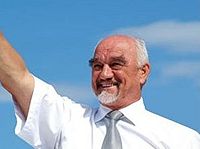
In the 1980s Mikhail Gorbachev's policies of perestroika and glasnost in the Soviet Union allowed political liberalization at a regional level. This led to the creation of various informal movements in the Moldavian SSR, and the resurgence of pro-Romanian nationalism among ethnic Moldovans.[66] The most prominent of these movements was the Popular Front of Moldova. Since the spring of 1988, PFM demanded from the Soviet authorities to declare Moldovan the only state language, to return to the use of the Latin alphabet and to recognize the shared ethnic identity of Moldovans and Romanians. The more radical factions of the Popular Front used extremely anti-minority, ethnocentric and chauvinist rhetoric.[67][68] Some have called for minority populations, particularly the Slavs (mainly Russians and Ukrainians) and Gagauz, to leave or be expelled from Moldova.[69]
On August 31, 1989, the Supreme Soviet of the Moldavian SSR adopted Moldovan as the only official language, with Russian retained only for secondary purposes, returned Moldovan to the Latin alphabet, and declared a shared Moldova-Romanian linguistic identity. As plans for major cultural changes in Moldova were made public, tensions rose further. Ethnic minorities felt threatened by the prospects of removing Russian as the de facto official language, the possible future reunification of Moldova and Romania and the ethnocentric rhetoric of the Popular Front. The Yedinstvo (Unity) Movement, established by the Slavic population of Moldova, pressed for the equal status given to both Russian and Moldovan.[70]
The nationalist Popular Front won the first free parliamentary elections in the Moldavian SSR in the spring of 1990, and its agenda started slowly to be implemented. On September 2, 1990, the Pridnestrovian Moldavian Soviet Socialist Republic was proclaimed as a Soviet republic by an ad hoc assembly, the Second Congress of the Peoples' Representatives of Transnistria. The situation in the country was escalating into violence, in October 1990 the Popular Front called for volunteers to form armed militias in order to stop a Gagauz autonomy referendum by coercion. In response, volunteer militias were formed in Transnistria. In April 1990 nationalist mobs attacked ethnic Russian members of parliament, while the Moldovan police refused to intervene or restore order.[71]
Citing the restriction of civil rights of ethnic minorities by Moldova as the cause of the dispute, in the interest of preserving a unified Moldavian SSR within the USSR and preventing the situation escalating further into violence the then Soviet President Mikhail Gorbachev declared the Transnistria proclamation to be lacking legal basis and annulled it by presidential decree on December 22, 1990.[72][73] Nevertheless, there was no significant actions taken against Transnistria and the new authorities were slowly able to establish control of the region.
The War of Transnistria followed armed clashes on a limited scale which broke out between Transnistrian separatists and Moldova as early as November 1990 at Dubăsari. Volunteers, including Cossacks, came from Russia and Ukraine to help the separatist side.[74] In mid-April 1992, in accordance with the agreements concerning the split of the military equipment of the former Soviet Union, negotiated between the former 15 republics in the previous months, Moldova created its own Defense Ministry. According to the decree of its creation, most of the 14th Soviet Army's military equipment was to be retained by Moldova.[75] Starting from March 2, 1992, there was concerted military action between Moldova and Transnistria. Throughout early-1992 the fighting intensified. The former Soviet 14th Guards Army entered the conflict in its final stage, opening fire against Moldovan forces;[76] since then, Moldova has exercised no effective control or influence on PMR authorities. A ceasefire agreement was signed on July 21, 1992 and has held to the present day.

The OSCE is trying to facilitate a negotiated settlement. Under OSCE auspices, on May 8, 1997, the Moldovan President Petru Lucinschi and the Transnistrian president Igor Smirnov, signed the "Memorandum on the principles of normalizations of the relations between the Republic of Moldova and Transnistria", also known as the "Primakov Memorandum", sustaining the establishment of legal and state relations, although the memorandum's provisions had diverging legal and political interpretations in Chişinău and Tiraspol.
In November 2003, Dmitry Kozak, a counselor of the Russian president Vladimir Putin, proposed a memorandum on the creation of an asymmetric federal Moldovan state, with Moldova holding a majority and Transnistria being a minority part of the federation.[77] Known as "the Kozak memorandum", it did not coincide with the Transnistrian position, which sought equal status between Transnistria and Moldova, but was giving Transnistria veto powers, which hence agreed to sign it. Vladimir Voronin was initially supportive of the plan, but refused to sign it after internal opposition and international pressure from the OSCE and US, and after Russia had endorsed the Transnistrian demand to maintain a Russian military presence for the next 20 years as a guarantee for the intended federation.[78] The refusal by the Moldovan side resulted in the sudden and long-term cooling of relations between Moldova and Russia, and halted further progress in the settlement negotiations.
Demographics
At the census of 1989, the population was 679,000 (including all the localities in the security zone, even those under Moldovan control). At the time of the 2004 census, the population was 555,347 (only localities under Transnistrian control)[79][80].
The Transnistrian authorities organized a separate census from the 2004 Moldovan Census, and therefore demographic statistics of Moldova do not include data from Transnistria.[81].
According to the 2004 Census in Transnistria, ethnic Moldovans compose the plurality with 31.9%, followed by ethnic Russians 30.4%, and Ukrainians 28.8%. Smaller numbers of Bulgarians, Poles, Germans, Jews, Gagauz, Belarusians and others make up the rest, totaling 8.9%. 64.2% of the population belongs to some ethnic Slav group (Russians, Ukrainians, Bulgarians, Poles, Belarusians).
The ethnic composition of the region has not been stable in the recent history, with the most notable change being the decrease of the Moldovan ethnic population and increase of the Russian.
Religion
Most religious Transnistrians are Orthodox Christians and the government has supported restoration and new construction of orthodox churches.
Transnistria's government affirms that the republic has freedom of religion and 114 religious beliefs and congregations are officially registered.
However, as of 2005, registration hurdles were encountered by some religious groups, notably the Jehovah's Witnesses.[82] In 2007, the US-based Christian Broadcasting Network denounced the persecution of Protestants.[83]
Economy
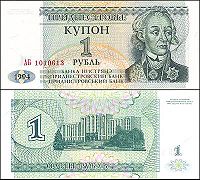
Transnistria has a mixed economy. Following a large scale privatization process in the late 90s[84], most of the companies in Transnistria are now privately owned. The economy bases on a mix of heavy industry (steel production), electricity production and manufacturing (textile production), which together accounts about 80% of the total industrial output.[85]
Transnistria has its own central bank, which issues Transnistrian currency, the Transnistrian ruble. It is convertible at a freely floating exchange rate but only in Transnistria.[86]
Economic history
After World War II, Transnistria was heavily industrialised, to the point that in 1990, it was responsible for 40% of Moldova's GDP and 90% of its electricity[87] despite the fact that it accounted for only 17% of Moldova's population. After the collapse of the Soviet Union, Transnistria wanted to return to a "Brezhnev-style planned economy".[88] However, several years later, it decided to head toward a market economy.
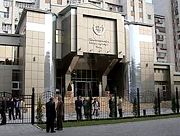
Macroeconomics
According to the government of Transnistria, the 2007 GDP was 6789 mln PMR roubles (appx US$799 million) and the GDP per capita was about US$1,500. The GDP increased by 11.1% and inflation rate was 19.3%.[89] Transnistria's government budget for 2007 was US$246 million, with an estimated deficit of approximately US$100 million[90] which the government plans to cover with income from privatizations.[91] Budget for 2008 is US$331 million, with an estimated deficit of approximately US$80 million.[92]
In 2004, Transnistria had debt of US$1.2 billion (two thirds of which are with Russia), which was per capita approximately 6 times higher than in Moldova (without Transnistria).[93] In March 2007 the debt to Gazprom for the natural gas has increased to US$1.3 billion. On 22 March 2007 Gazprom sold Transnistria's gas debt to the Russian businessman Alisher Usmanov, who controls Moldova Steel Works, the largest enterprise in Transnistria. Transnistria's president Igor Smirnov has announced that Transnistria will not be paying off its gas debt because "Transdnistria has no legal debt [to Gazprom]".[94][95] In November 2007, the total debt of Transnistria's public sector was increased up to US$1.64 billion.[92]
According to Yevgeni Shevchuk, speaker of Transnistrian Supreme Soviet, Transnistria is in a difficult economic situation. Despite a 30% tax increase in 2007 pension fund is still lacking money and emergency measures must be taken[96]. However, the situation is not hopeless and it can not be considered a crisis, as a crisis mean three-months delays in payment of pensions and salaries[97].
External trade
In 2006, the Transnistrian Republican Bank reported exports of US$422.0 million and imports of US$738.4 million. Compared to 2005, export decreased 27.2% and import decreased 13.7%. The trade deficit reached US$316.3 million.[98] Over 50% of the export goes to the CIS, mainly to Russia, but also to Belarus, Ukraine and Moldova.[85][84] Main non-CIS markets for the Transnistrian goods are Italy, Egypt, Greece, Romania and Germany.[84] The CIS accounts for over 60% of the imports, while the share of the EU is about 23%. The main imports are non-precious metals, food products and electricity.
Economic sectors
The leading industry is steel, due to the Moldova Steel Works (part of the Russian Metalloinvest holding) in Rîbniţa (Rybnitsa), which accounts for about 60% of the budget revenue of Transnistria.[20] The largest company in the textile industry is Tirotex, which claimed to be the second largest textile company in Europe.[99] The energy sector is dominated by the Russian companies. The largest power company Moldavskaya GRES (Cuchurgan power station), which is located in Dnestrovsk, is owned by Inter RAO UES, the joint subsidiary of RAO UES and Rosenergoatom,[100] and the gas transmission and distribution company Tiraspoltransgas is probably controlled by Gazprom, although Gazprom has not confirmed the ownership officially. The banking sector of Transnistria consists 8 commercial banks, including Gazprombank. The oldest alcohol producer Kvint, located in Tiraspol, produces and exports brandy, wines and vodka.
Human rights
The human rights record of Transnistria has been criticised by several governments and international organizations. The 2007 Freedom in the World report, published by the US-based Freedom House, described Transnistria as a "non-free" territory, having an equally bad situation in both political rights and civil liberties.[101]
According to the U.S. Department of State report referring to year 2006, The right of citizens to change their government[102] was restricted[...] Authorities reportedly continued to use torture and arbitrary arrest and detention.[...]In Transnistria authorities limited freedom of speech and of the press.[...]Authorities usually did not permit free assembly.[...] In the separatist region of Transnistria the authorities continued to deny registration and harassed a number of minority religions groups.[...]The separatist region remained a significant source and transit area for trafficking in persons.[...] Homosexuality was illegal, and gays and lesbians were subject to governmental and societal discrimination.[103]
Incidents
In the best known political process, Ilie Ilaşcu was convicted in 1993 of killing two Transnistrian officials, and initially sentenced to death by Transnistria's Supreme Court, however this was repealed to a life prison sentence. Three other members of his group were sentenced to terms of 12 to 15 years' imprisonment, and confiscation of their property. Ilaşcu was released in 2001, following a decision of the European Court of Human Rights against Moldova and Russia, while the other three were released in 2004 and 2007, when they finished serving their sentences. ECHR stated the authorities have broken the right of freedom and safety to all 4 members of his group, and the treatment Ilie Ilaşcu suffered is qualified as torture. As part of the ruling the court also stated that they believe Transnistria was "under the effective authority or at least decisive influence of Russia".[104] The court also ordered Moldova and Russia—which backs Transnistria—to pay the four a total of €750,000 (US$1,000,000) in compensation for the deprivation of their freedom, and for torture and inhumane treatment while in custody.[105] The members of Ilaşcu group were forced to exile after their release from prison.
In March 2007 several opponents of Transnistrian regime were arrested as they made public appeals for a protest rally against the Tiraspol regime's policy[106]. On 19 March 2007 Transnistrian authorities had also arrested Ştefan Urîtu, the leader of Moldovan Helsinki Committee for Human Rights, and two other local political activists. They were released later.[107]
According to the Moldovan InfoTag news agency, Transnistrian authorities blocked the polling station of the Corjova village, not allowing residents to participate in the Moldovan elections of June 3, 2007.[108] At the same occasion, Iurie Cotofana, a local antiseparatist councilor was arrested and beaten. Valentin Besleag, a candidate for mayoral office in Corjova was arrested in 2 June for carrying electoral material from Moldova.[109]
Situation of the media
There is a regular mix of modern news media in Transnistria with a number television stations, newspapers, and radio stations.
According to the OSCE, the media climate in Transnistria is restrictive and the authorities continue a long-standing campaign to silence independent opposition voices and groups.[110].
According to a U.S. Department of State report for 2006, Both of region's major newspapers were controlled by the authorities. However , no evidence has been produced to support these claims. There was one independent weekly newspaper in Bendery and another in the northern city of Rîbniţa.[...]Separatist authorities harassed independent newspapers for critical reporting of the Transnistrian regime.[...]Most television and radio stations and print publication were controlled by Transnistrian authorities, which largely dictated their editorial policies and finance operations. Some broadcast networks, such as the TSV television station and the INTER-FM radio station, were owned by Transnistria's largest monopoly, Sheriff, which also holds a majority in the region's legislature.[...]In July 2005 the Transnistrian Supreme Soviet amended the election code to prohibit media controlled by the Transnistrian authorities from publishing results of polls and forecasts related to elections.[111]
Moldovan schools
Transnistrian local authorities insist that public education for ethnic Moldovans in their mother tongue is done using the Soviet-originated Moldovan Cyrillic alphabet, having restricted the usage of the Latin script (the norm) for the Romanian language to only 6 schools. Four schools (of the remaining six) that performed their instruction into the Romanian language.[112] Schools using the Latin script were forcibly closed by the authorities, who claimed this was due to the refusal of the schools to apply for official accreditation. These schools were later registered as private schools and reopened. This process may have been accelerated by pressure from the European Union [113]
The OSCE mission to Moldova has urged local authorities in the Transnistrian city of Rîbniţa to return a confiscated building to the Moldovan Latin script school located in the city. The unfinished building was nearing completion in 2004, when Transnistria took control of it during that year's school crisis.[114]
"In November 2005 Ion Iovcev, the principal of a Romanian-language school in Transnistria and active advocate for human rights as well as a critic of the Transnistrian leadership, received threatening calls that he attributed to his criticism of the separatist regime."[115]
- See also: Russification and Anti-Romanian discrimination
Security concerns
Arms control and disarmament
Following the collapse of the former Soviet Union the Russian 14th Army left behind 40,000 tonnes of weapony and ammunition. In the subsequent years there were concerns that the Transnistrian authorities may try to sell these stocks internationally and intense pressure was applied to have these removed by the Russian Federation.
In 2000 and 2001, the Russian Federation withdrew by rail 141 self-propelled artillery and other armoured vehicles and destroyed locally 108 T-64 tanks and 139 other pieces of military equipment limited by the Treaty on Conventional Armed Forces in Europe (CFE). During 2002 and 2003 Russian military officials destroyed a further 51 armoured vehicles, all of which were types not limited by the CFE Treaty. The OSCE also observed and verified the withdrawal of the 48 trains with military equipment and ammunition in 2003. However, no further withdrawal activities have taken place since March 2004 and a further 20,000 tons of ammunition, as well as some remaining military equipment are still to be removed. In the Autumn of 2006 the Transnistria leadership agreed to let an OSCE inspectorate examine the munitions and further access agreed moving forward. Recent weapons inspections were permitted by Transnistria and conducted by the OSCE.[116][117] The onus of responsibility rests on the Russian Federation to remove the remainder of the supplies.
Transnistrian authorities declared that they are not involved in the manufacture or export of weapons.[118] Mark Almond of BHHRG stated that accusations of state-sponsored weapons smuggling in the PMR appear to be groundless and politically motivated, rather than based on any verified facts.[119]
The OSCE and European Union officials state that there is no evidence that Transnistria has ever, at any time in the past, trafficked arms or nuclear material.[120]
Foreign experts working on behalf of the United Nations say that the historically low levels of transparency and continued denial of full investigation to international monitors has reinforced negative perceptions of the Transnistrian regime, although recent good levels of cooperation on the part of Transnitrian authorities in some areas may reflect a shift in the attitude of PMR.[121] Also it says that the evidence for the illicit production and trafficking of weapons into and from Transnistria has in the past been exaggerated, that although the trafficking of light weapons is likely to have occurred before 2001 (the last year when export data showed US$ 900,000 worth of 'weapons, munitions, their parts and accessories' exported from Transnistria. The report also states that the same holds true for the production of such weapons, which is likely to have been carried out in the 1990s primarily to equip Transnistrian forces.
The OSCE mission spokesman Claus Neukirch spoke about this situation: "There is often talk about sale of armaments from Transnistria, but there is no convincing evidence."[122]
Personal security
On May 25, 2007, Valeri Emelianov, a Tiraspol city councillor, was shot dead.[123][124]
In March 2007, Victor Neumoin, a local politician was shot dead[125].
In July 2006, a bomb killed eight in a Tiraspol minibus[126], and in August 2006, a grenade explosion in a Tiraspol trolleybus killed two and injured ten.[127]
See also
- Commonwealth of Unrecognized States
References
- ↑ "Население Приднестровья за полгода сократилось на 3,5 тыс. человек," Novy region 2, 7 September 2007. http://www.nr2.ru/pmr/138729.html
- ↑ Herd, Graeme P.; Jennifer D. P. Moroney (2003). Security Dynamics in the Former Soviet Bloc. Routledge. ISBN 041529732X.
- ↑ Zielonka, Jan (2001). Democratic Consolidation in Eastern Europe. Oxford University Press. ISBN 019924409X.
- ↑ , Jos Boonstra, Senior Researcher, Democratisation Programme, FRIDE. Moldova, Transnistria and European Democracy Policies, 2007
- ↑ Gerald Hinteregger, Hans-Georg Heinrich (editors), Russia - Continuity and Change, Hinteregger, Gerald; Heinrich Hans-Georg (2004). Russia - Continuity and Change. (editors). Springer. pp. 174. ISBN 3211223916.
- ↑ Rosenstiel, Francis; Edith Lejard, Jean Boutsavath, Jacques Martz (2002). Annuaire Europeen 2000/European Yearbook 2000. Martinus Nijhoff Publishers. ISBN 9041118446.
- ↑ 7.0 7.1 Barry Bartmann, Tozun. Bahcheli (2004). De Facto States: The Quest for Soverignty. Routledge. ISBN 0714654760.
- ↑ OSCE: De Gucht Discusses Montenegro Referendum, Frozen Conflicts, GlobalSecurity.org, Radio Free Europe/Radio Liberty, May 2006
- ↑ Vladimir Socor, Frozen Conflicts in the Black Sea-South Caucasus Region, IASPS Policy Briefings, 1 March 2004
- ↑ "Абхазия, Южная Осетия и Приднестровье признали независимость друг друга и призвали всех к этому же". Newsru (2006-11-17). Retrieved on 2008-08-31.
- ↑ Regions and territories: Trans-Dniester, BBC News, 7 March 2007
- ↑ The black hole that ate Moldova: A glimpse inside Transdniestria, Economist, May 3rd, 2007
- ↑ What's in a name: "Pridnestrovie" vs "Transnistria", Pridnestrovie.net, undated
- ↑ Trygve Kalland and Claus Neukirch, Moldovan Mission seeks solution to Dorotcaia's bitter harvest, OSCE, 10 August 2005
- ↑ New checkpoint to appear in Moldova conflict zone after clash, RIA Novosti, 13 January 2007
- ↑ (Romanian) Locuitorii satului Vasilievca de pe malul stâng al Nistrului trăiesc clipe de coşmar, Deutsche Welle, 17 March 2005
- ↑ The Tiraspol Times, June 8, 2007, http://www.tiraspoltimes.com/node/967
- ↑ Voronin calls Transnistria conflict 'very resolvable' (Deutsche Presse-Agentur)
- ↑ Nearly 400 thousand Transnistrians have Moldovan passports (azi.md)
- ↑ 20.0 20.1 20.2 Moldova Strategic Conflict Assessment (SCA), Stuart Hensel, Economist Intelligence Unit.
- ↑ Moldova Azi, Transnistrian Militia Withdrew Its Posts from Vasilievca, accessed 2006-10-18
- ↑ Moldpres News Agency, Ineffectiveness of peacekeeping mechanism leads to incidents in Moldova's security zone, May 14, 2007, accessed June 4, 2007
- ↑ PMR Supreme Council (Parliament of Transnistria's official website)
- ↑ BHHRG: Transnistria 2006: Is Regime Change Underway?
- ↑ 9 were born in the Russian Federation, 8 in Ukraine, 2 in Kazakhstan, 1 in Germany, 1 in Belarus, and 3 did not declare.
- ↑ PMR Supreme Concil: Members of Parliament Supreme Council of the PMR. Retrieved 2006, 12-27
- ↑ Transnistria's "Government" Showcases Foreign, Minority Rule by Vladimir Socor, Eurasia Daily Monitor
- ↑ (Some) international observers call elections free, democratic Pridnestrovie.net. Retrieved 2006, 12-27
- ↑ Moldova and the Dniestr Region: Contest Past, Frozen Present, Speculative Futures? Herd, Graeme P.; Conflict Studies Research Centre; 2005; Accessed 25 May 2007;
- ↑ US Department of State, Country Report on Human Rights Practices in Moldova - 2003
- ↑ Ţăranu, A; Grecu, M. The policy of linguistic cleansing in Transnistria page 26-27 Retrieved 2006, 12-27
- ↑ Министерство юстиции ПМР вынесло предупреждение общественному движению "Власть народу! За социальную справедливость!" и "Партии народовластия" (Ministry of Justice of PMR warned Power to the People movement and Narodovlastie party), Ольвия Пресс, 27-02-01 (Russian)
- ↑ Council Decision 2006/96/CFSP of 14 February 2006 implementing Common Position 2004/179/CFSP concerning restrictive measures against the leadership of the Transnistrian region of the Republic of Moldova European Union Law- Official Journal. Feb 2, 2006. Retrieved 2006, 12-27
- ↑ Transnistria: New Social Democratic party wants union with Moldova Tiraspol Times. Feb. 6, 2007. Retrieved 2007, 2-19
- ↑ Tiraspol not willing to register opposition representative in electoral race
- ↑ Andrey Safonov will be able to enter the election for the seat of president
- ↑ TRANSNISTRIAN COMMUNIST PARTY LEADER RELEASED ON PROBATION
- ↑ Pridnestrovie.de, 1 July 2008 Pridnestrovie's Aussenminister Valeri Litskai entlassen
- ↑ Новый Регион (New Region), 1 July 2008 Министр иностранных дел Приднестровья отправлен в отставку
- ↑ Olvia Press: "Valeri Litskai: A situation based on pressure and threats cannot be considered favorable for the revival of contacts"
- ↑ Russia's humanitarian assistance is a planned propagandist action, Chisinau claims
- ↑ Pridnestrovie per-capita GDP up 17.3% despite economic warfare
- ↑ "Nezavisimaya Moldova", 25 October 1994; Informative Report of FAM of RM, nr.2, October 1994, pp. 5-6
- ↑ Mihai Grecu, Anatol Ţăranu, Trupele Ruse în Republica Moldova (Culegere de documente şi materiale). Chişinău, 2004 , p. 600.
- ↑ "Interfax", Moscow, in Russian, 0850 gmt, 7 July 2004
- ↑ Mihai Gribincea, "Russian troops in Transnistria – a threat to the security of the Republic of Moldova", Institute of Political and Military Studies, Chişinău, Moldova Russia continues to 'sustain the Dniestr region as a quasi-independent entity through direct and indirect means'
- ↑ MC.DEL/21/04, 6 December 2004
- ↑ Interfax. NATO must recognize Russia's compliance with Istanbul accords Jun 14, 2007. Retrieved [[November 18}11-18]], 2007
- ↑ NATO-resolution. 11. b.
- ↑ The Laurentian Codex of the Primary Chronicle ([1]) contains the following lines (translated): Ulichi, Tivertsy lived along the Dniester; a lot of them settled on the Danube; settled along the Dniester down to the sea, their cities can be found unto this day.
- ↑ Porphyrogenitus, Constantine. De Administrando Imperio ca. 950. Retrieved 2006, 12-27
- ↑ George Reichersdorf: Moldaviæ quæ olim Daciæ pers, chorographia, Georgio a Reichersdorf Transilvano auctore, Viennæ 1541.
- ↑ Bronovius and Georg Werner: "Transylvania, Moldavia and Chersonesus Tauricæ'". Published by Arnold Mylius, Cologne, 1595.
- ↑ Antonio Bonfini (1434 - 1503): Rerum Ungaricarum decades quatuor cum dimidia
- ↑ Giovanni Botero (1540-1617): Relazioni universali, Venice, 1591
- ↑ Giovanni Antonio Magini (1555-1617): Geographie universae, Venice, 1596.
- ↑ N. Iorga, Românii de peste Nistru, "Basarabia", nr. 11/1992, page 87
- ↑ Viorel Dolha, "Totul despre Transnistria", http://www.aiarad.ro/forum/viewtopic.php?t=39
- ↑ E.Şt. Holban, Figuri basarabene, "Basarabia", nr.1/1992
- ↑ Andrew Wilson: "The Ukrainians: Engaging the Eastern Diaspora" (Westview Press, 1998)
- ↑ E. Lozovan, Românii orientali de la Nistru la Vladivostok, "Neamul Românesc", nr.1/1991, page 32
- ↑ N. Iorga, Românii de peste Nistru, "Basarabia", nr.11/1992, page 89
- ↑ Averko, Michael. Russia's Stance on Disputed Territories: Just How "Hypocritical" is it? The American Journal of Russian and Slavic Studies. Retrieved 2006, 12-27
- ↑ About Transdnistrea World Window NGO. Retrieved 2006, 12-27
- ↑ The Politics of State Building: Centre-Periphery Relations in Post-Soviet Ukraine, Roman Solchanyk, Europe-Asia Studies, Vol. 46, No. 1 (1994), pp. 47-68
- ↑ Timeline: Moldova BBC Country Profile: Moldova
- ↑ Chechnya: Tombstone of Russian Power, Anatol Lieven, Yale University Press, 1999, ISBN 0300078811, pp 246
- ↑ Can Liberal Pluralism Be Exported?, Will Kymlicka, Magdalena Opalski, Oxford University Press, 2001, ISBN 0199240639, pp 208
- ↑ The painful past retold Social memory in Azerbaijan and Gagauzia, Hülya Demirdirek, Postkommunismens Antropologi, University of Copenhagen, 12-14 April 1996
- ↑ Andrei Panici. Romanian Nationalism in the Republic of Moldova, The Global Review of Ethnopolitics Vol. 2 no. 2, January 2003, 37-51
- ↑ Modern Hatreds: The Symbolic Politics of Ethnic War, Stuart J. Kaufman, Cornell University Press, 2001, ISBN 0801487366, pp 144
- ↑ ;Kolsto, et al. "The Dniester Conflict: Between Irredentism and Separatism," Europe-Asia Studies, Vol. 45, No. 6 (1993): 108.
- ↑ "Ukaz Prezidenta Soiuza Sovetskikh Sotsialisticheskikh Respublik O Merakh po Normalizatsii Obstanovki v SSR Moldova," Sovetskaia Moldova, no. 295 (17249), December 23, 1990, 1.
- ↑ Несколько хронологических данных о начале и эволюции войны
- ↑ Mikhail Bergman, Вождь в чужой шкуре. (Russian)
- ↑ Kazakov, Anatolii Mikhailovich. Krovavoe leto v benderakh – zapiski pokhodnogo atamana. http://artofwar.ru/k/kazakow_a_m/text_0420.shtml (in Russian)
- ↑ Moldova Matters: Why Progress is Still Possible on Ukraine's Southwestern Flank, Pamela Hyde Smith, The Atlantic Council of the United States, March 2005
- ↑ Netherlands Institute of International Relations - The OSCE Moldova and Russian diplomacy 2003 page - 109
- ↑ Official data from 2004 census and comparison with the 1989 census, by Olvia Press
- ↑ Pridnestrovie.net: "2004 Census: PMR urban, multilingual, multicultural" from http://www.pridnestrovie.net retrieved 2006, 2-24
- ↑ Trends in Europe and North America (Explanatory Notes), United Nations Economic Commission for Europe (UNECE).
- ↑ Moldova, International Religious Freedom Report 2005, released by the US Department of State Bureau of Democracy, Human Rights, and Labor
- ↑ Christians Face Abuse from Corrupt Regime, by Gary Lane, CBN News, 6 April 2007
- ↑ 84.0 84.1 84.2 International Crisis Group, Moldova:Regional tensions over Transdniestria, 17 June 2004
- ↑ 85.0 85.1 Transnistria, Center for Economic Polices of IDIS "Viitorul"
- ↑ Pridnestrovie's own currency, Pridnestrovie.net
- ↑ John Mackinlay and Peter Cross (editors), Regional Peacekeepers: The Paradox of Russian Peacekeeping, United Nations University Press, 2003, ISBN 92-808-1079-0 p. 135
- ↑ John B. Dunlop, "Will a Large-Scale Migration of Russians to the Russian Republic Take Place over the Current Decade?", in International Migration Review, Vol. 27, No. 3. (Autumn, 1993), pp. 605-629, citing Russian Radio, September 21, 1992 in Russia and CIS Today, WPS, September 21, 1992, p. 976/16.
- ↑ Доклад «Социально-экономическое развитие Приднестровской Молдавской Республики» за 2007 года (уточнение) (Socio-economical development of the Pridnestrovian Moldovan Republic), statistical service of the Ministry of Economy
- ↑ Transnistrian parliament adopts region's budget for 2007
- ↑ Privatization will solve the budget problem PMR News, February 21, 2007
- ↑ 92.0 92.1 Евгений Шевчук: бюджет Приднестровья – отражение реальной ситуации в экономике
- ↑ Democracy in Secessionism: Transnistria and Abkhazia's Domestic Policies, by Nicu Popescu, International Policy Fellowship Program 2005/2006
- ↑ Moscow's Hand Tired of Giving, Kommersant 6 Aprill 2007
- ↑ «Газпром» передал Приднестровье Алишеру Усманову, Nezavisimaya Gazeta 23 March 2007
- ↑ Shevchuk answering a question about 2007 Transnistrian budget
- ↑ Shevchuk explaining that economical situation is not critical
- ↑ [2], Transnistrian Republican Bank, Tiraspol 2007
- ↑ Tirotex official website
- ↑ Annual Report of Inter RAO UES
- ↑ Freedom House, http://www.freedomhouse.org/uploads/press_release/fiw07_charts.pdf 2007 "Freedom in the World" report]
- ↑ the Government of Moldova
- ↑ United States Department of State: Country Reports on Human Rights Practices - 2006
- ↑ Grand Chamber judgment in the case of Ilaşcu and others v. Moldova and Russia, European Court of Human Rights, 349, 8 July 2004
- ↑ International Herald Tribune, Pro-Russian separatists in Moldova release last political prisoner, June 4, 2007
- ↑ Transnistrian power wielding forces hold over ten opponents of breakaway regime
- ↑ Separatiştii transnistreni l-au arestat pe Ştefan Urîtu şi doi membri ai unui ONG local (in Romanian)
- ↑ Prokuratura initials proceedings on Corjova case
- ↑ Amnesty International report about the arrest of Besleag
- ↑ OSCE - Media in Transdniestria
- ↑ United States Department of State report for 2006
- ↑ Statement by the Ministry of Education, Pridnestrovian Moldavian Republic, on the question of children's educational rights insurance, published by Olivia-Press on 15 July 2004
- ↑ Several Transnistrian officials were banned from traveling through EU [3]
- ↑ Ribnitsa's authorities must return the confiscated school building, says OSCE Mission Head
- ↑ United States Department of State report for 2006
- ↑ UN Report clears Transdniester of weapons smuggling; Praises transparency and co-operation Tiraspol Times. Oct 16, 2006. Retrieved 2007, 2-21
- ↑ Confidence-building visit: OSCE delegation inspects Kolbasna military depots Tiraspol Times. Nov 13, 2006. Retrieved 2007, 2-21
- ↑ PMR doesn't make weapons, experts admit
- ↑ Mark Almond: Kafka and the Arms Smugglers
- ↑ RFE/RL: Western Diplomats Say Reports Of Smuggling From Transdniester Likely Exaggerated
- ↑ UNDP: 2006 Small arms and light weapons survey of Moldova, SEESAC 1 July 2007, ISBN 86-7728-014-6
- ↑ Conflict Studies Research Centre, [http://www.defac.ac.uk/colleges/csrc/document-listings/cee/05(07)-GPH.pdf Moldova & The Dniestr Region: Contested Past, Frozen Present, Speculative Futures?], Graeme P. Herd
- ↑ (Romanian) Transnistria.md, La Tiraspol a mai fost asasinat un politician, 05/28/2007
- ↑ (Russian) Lenta.pmr, "Лидер НДП "ПРОРЫВ!": Валерий Емельянов был хорошим депутатом, но не был политиком
- ↑ Trans-Dniester politician close to separatist leader's son shot dead (Associated Press)
- ↑ Trans-Dniester blast kills eight BBC
- ↑ Grenade exploded in Tiraspol trolley bus
External links
- Wikimedia Atlas of Transnistria
- BBC: Profile of Trans-Dniester
- Economist: The black hole that ate Moldova
- OSCE Mission to Moldova
- Radio Free Europe: Transdniester Conflict Was Long In The Making
- Jos Boonstra, "Moldova, Transnistria, and European Democracy Polices", FRIDE, February 2007
- Stuart Hensel, Moldova Strategic Conflict Assessment (SCA), Economist Intelligence Unit.
Local links
- (Russian) "Chelovek i ego Prava" ("Man and his Rights"), local newspaper
- (English)(Romanian)(Russian) Conflict.md, site about the conflict
- (English)(Romanian)(Russian) Moldova Azi: News from Moldova, news portal
- (English)(Romanian)(Russian) Moldova.org, non-governmental country portal
- (English)(Russian) PMR News, English-language news and commentaries
- (English)(Russian) Pridnestrovie.net, official English site of the PMR authorities
- (English)(Romanian)(Russian) Transnistria.md, English-language news and interviews
- (English)(Russian) VisitPMR.com, official tourist information
- (English)(Russian) Website of the Supreme Council (Parliament) of PMR, official site
|
|
|||||||||||||||||||||||||||||||||||||||||||||||||
|---|---|---|---|---|---|---|---|---|---|---|---|---|---|---|---|---|---|---|---|---|---|---|---|---|---|---|---|---|---|---|---|---|---|---|---|---|---|---|---|---|---|---|---|---|---|---|---|---|---|
|
|||||||||||||||||||||||||||||||||||||||||||||||||

